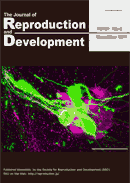57 巻, 3 号
June
選択された号の論文の18件中1~18を表示しています
- |<
- <
- 1
- >
- >|
Original Article
-
原稿種別: -Original Article-
2011 年 57 巻 3 号 p. 317-321
発行日: 2011年
公開日: 2011/07/07
[早期公開] 公開日: 2009/05/15PDF形式でダウンロード (181K) -
原稿種別: -Original Article-
2011 年 57 巻 3 号 p. 322-326
発行日: 2011年
公開日: 2011/07/07
[早期公開] 公開日: 2011/01/28PDF形式でダウンロード (292K) -
原稿種別: -Original Article-
2011 年 57 巻 3 号 p. 327-334
発行日: 2011年
公開日: 2011/07/07
[早期公開] 公開日: 2011/01/28PDF形式でダウンロード (305K) -
原稿種別: -Original Article-
2011 年 57 巻 3 号 p. 335-341
発行日: 2011年
公開日: 2011/07/07
[早期公開] 公開日: 2011/01/28PDF形式でダウンロード (542K) -
原稿種別: -Original Article-
2011 年 57 巻 3 号 p. 342-345
発行日: 2011年
公開日: 2011/07/07
[早期公開] 公開日: 2011/01/18PDF形式でダウンロード (104K) -
原稿種別: -Original Article-
2011 年 57 巻 3 号 p. 346-354
発行日: 2011年
公開日: 2011/07/07
[早期公開] 公開日: 2011/01/28PDF形式でダウンロード (311K) -
原稿種別: -Original Article-
2011 年 57 巻 3 号 p. 355-364
発行日: 2011年
公開日: 2011/07/07
[早期公開] 公開日: 2011/01/28PDF形式でダウンロード (696K) -
原稿種別: -Original Article-
2011 年 57 巻 3 号 p. 365-372
発行日: 2011年
公開日: 2011/07/07
[早期公開] 公開日: 2011/02/25PDF形式でダウンロード (433K) -
原稿種別: -Original Article-
2011 年 57 巻 3 号 p. 373-378
発行日: 2011年
公開日: 2011/07/07
[早期公開] 公開日: 2011/02/14PDF形式でダウンロード (263K) -
原稿種別: -Original Article-
2011 年 57 巻 3 号 p. 379-384
発行日: 2011年
公開日: 2011/07/07
[早期公開] 公開日: 2011/02/25PDF形式でダウンロード (359K) -
原稿種別: -Original Article-
2011 年 57 巻 3 号 p. 385-392
発行日: 2011年
公開日: 2011/07/07
[早期公開] 公開日: 2011/02/14PDF形式でダウンロード (658K) -
原稿種別: -Original Article-
2011 年 57 巻 3 号 p. 393-402
発行日: 2011年
公開日: 2011/07/07
[早期公開] 公開日: 2011/02/18PDF形式でダウンロード (364K) -
原稿種別: -Original Article-
2011 年 57 巻 3 号 p. 403-408
発行日: 2011年
公開日: 2011/07/07
[早期公開] 公開日: 2011/02/18PDF形式でダウンロード (251K) -
原稿種別: -Original Article-
2011 年 57 巻 3 号 p. 409-415
発行日: 2011年
公開日: 2011/07/07
[早期公開] 公開日: 2011/02/25PDF形式でダウンロード (392K) -
原稿種別: -Original Article-
2011 年 57 巻 3 号 p. 416-420
発行日: 2011年
公開日: 2011/07/07
[早期公開] 公開日: 2011/03/08PDF形式でダウンロード (214K) -
原稿種別: -Original Article-
2011 年 57 巻 3 号 p. 421-427
発行日: 2011年
公開日: 2011/07/07
[早期公開] 公開日: 2011/03/26PDF形式でダウンロード (301K)
Technology Report
-
原稿種別: -Technology Report-
2011 年 57 巻 3 号 p. 428-432
発行日: 2011年
公開日: 2011/07/07
[早期公開] 公開日: 2011/02/14PDF形式でダウンロード (176K) -
原稿種別: -Technology Report-
2011 年 57 巻 3 号 p. 433-436
発行日: 2011年
公開日: 2011/07/07
[早期公開] 公開日: 2011/03/08PDF形式でダウンロード (170K)
- |<
- <
- 1
- >
- >|
